Accommodation · Attractions · Bed & Breakfasts · Europe · Food and Drink · France · Going Out · Hotels · Regions · Travel Miscellany · Western Europe
10 reasons why Occitanie may be the new Provence
Looking out from Toulouse the map looks invitingly blank. For Occitanie is the “other South of France”, intensely French, a sun-warmed countryside where livestock outnumber people.
 Occitanie? It’s the administrative replacement for Languedoc-Rousillion and Midi-Pyrenees bureaucratically butchered at midnight on 31st January 2015.
As Provence’s country sister, Occitanie does decadence in its own bucolic way – enjoying the traditional luxuries of good-food, fine wines and the time to savour them. For this rural paradise of quiet roads winding through vines and sunflowers hedonistically lives off the fat of the land.
With it hill-top mediaeval villages, Occitanie has more than it’s fair share of France’s “plus beaux villages”. There’s plenty to rival showy Provence with its designer sunglasses, crawling autoroutes and inflated price tags.
1. Cultured Auch
Auch has slowed down since the Middle Ages. Once bustling with pilgrims on their way to Santiago de Compostella, now it seems that the massive cathedral has outgrown its city.
Occitanie? It’s the administrative replacement for Languedoc-Rousillion and Midi-Pyrenees bureaucratically butchered at midnight on 31st January 2015.
As Provence’s country sister, Occitanie does decadence in its own bucolic way – enjoying the traditional luxuries of good-food, fine wines and the time to savour them. For this rural paradise of quiet roads winding through vines and sunflowers hedonistically lives off the fat of the land.
With it hill-top mediaeval villages, Occitanie has more than it’s fair share of France’s “plus beaux villages”. There’s plenty to rival showy Provence with its designer sunglasses, crawling autoroutes and inflated price tags.
1. Cultured Auch
Auch has slowed down since the Middle Ages. Once bustling with pilgrims on their way to Santiago de Compostella, now it seems that the massive cathedral has outgrown its city.
 As the historic heart of Gascony, in the department of Gers, pronounced rather like the beginning of Jerez, Auch’s quaint meandering cobbled streets slow you to Occitanie’s gentle strolling pace. Linger at your restaurant table, on the square, admiring buildings that survive from medieval times and some sharp topiary.
Visitors often guess that they could fit Auch’s entire population into the schizophrenic cathedral: Gothic exterior with Renaissance interior. Construction began in 1489 but by the time it was completed in the 17th century Gothic’s over-the- top fetish of ornate decoration was passé. To a 21st century minimalist eye Renaissance style also seems over-the-top.
D’Artagnan, of Three Musketeers fame, born nearby, is Auch’s local boy made good, and his statue stands behind the cathedral. The cathedral is at the heart of Auch’s lively arts programme and you may be able to catch a concert.
2. Chambres d’hôtes
Small, quirky, welcoming chambres d’hôtes, tucked away off gravelled lanes are the way to go in Occitanie. You are a guest rather than a customer. Stay in your own tower at Les Bruhasses, near Condom, mezzanine bedroom with lounge below. Garrulous Jean Royer, with numerous anecdotes of rural French life entertains you whilst his wife Helene plates up the local specialities and keeps the wine flowing. Gourmet food and immaculate English testifies to their past life of running a restaurant in Canada. But they wanted their children to enjoy French rural life, so they returned to their home land.
As the historic heart of Gascony, in the department of Gers, pronounced rather like the beginning of Jerez, Auch’s quaint meandering cobbled streets slow you to Occitanie’s gentle strolling pace. Linger at your restaurant table, on the square, admiring buildings that survive from medieval times and some sharp topiary.
Visitors often guess that they could fit Auch’s entire population into the schizophrenic cathedral: Gothic exterior with Renaissance interior. Construction began in 1489 but by the time it was completed in the 17th century Gothic’s over-the- top fetish of ornate decoration was passé. To a 21st century minimalist eye Renaissance style also seems over-the-top.
D’Artagnan, of Three Musketeers fame, born nearby, is Auch’s local boy made good, and his statue stands behind the cathedral. The cathedral is at the heart of Auch’s lively arts programme and you may be able to catch a concert.
2. Chambres d’hôtes
Small, quirky, welcoming chambres d’hôtes, tucked away off gravelled lanes are the way to go in Occitanie. You are a guest rather than a customer. Stay in your own tower at Les Bruhasses, near Condom, mezzanine bedroom with lounge below. Garrulous Jean Royer, with numerous anecdotes of rural French life entertains you whilst his wife Helene plates up the local specialities and keeps the wine flowing. Gourmet food and immaculate English testifies to their past life of running a restaurant in Canada. But they wanted their children to enjoy French rural life, so they returned to their home land.
 Quite simply oatmeal-coloured Domaine de Perches with its pool, probably Farrow and Ball “pitch blue” to complement the Negrette vineyards beyond, is the ultimate property porn. Picture windows framing sunset over the distant Montaigne Noire, an eclectic mix of antiques and contemporary art. Then when the sun has finally set – strategically placed table-lamps creating warm pools of light.
If you choose to park-up for the night Alain and Howard will share canapés with you, “a glass of something sparkling” and then a four-course dinner. In summer the table will be set al fresco on the decking by the pool. Idyllic is a word that cannot be overused at Domaine.
3. The village that floats in the sky
As one of the “Plus beaux villages” Cordes-sue- ciel is not to be missed. It’s a medieval
village that appears to float amongst the clouds on a misty day. Visitors park and then breathlessly climb the steep labyrinthian streets taking them past half-timbered houses that showcase the work of cedar wood carvers, painters and textile weavers. Enjoy vineyard views from cafes and restaurants at the summit.
Quite simply oatmeal-coloured Domaine de Perches with its pool, probably Farrow and Ball “pitch blue” to complement the Negrette vineyards beyond, is the ultimate property porn. Picture windows framing sunset over the distant Montaigne Noire, an eclectic mix of antiques and contemporary art. Then when the sun has finally set – strategically placed table-lamps creating warm pools of light.
If you choose to park-up for the night Alain and Howard will share canapés with you, “a glass of something sparkling” and then a four-course dinner. In summer the table will be set al fresco on the decking by the pool. Idyllic is a word that cannot be overused at Domaine.
3. The village that floats in the sky
As one of the “Plus beaux villages” Cordes-sue- ciel is not to be missed. It’s a medieval
village that appears to float amongst the clouds on a misty day. Visitors park and then breathlessly climb the steep labyrinthian streets taking them past half-timbered houses that showcase the work of cedar wood carvers, painters and textile weavers. Enjoy vineyard views from cafes and restaurants at the summit.
 Founded in 1222 Cordes was intended to be France’s answer to the commercial success of Spain‘s Córdoba. Layer after layer of defensive ramparts demonstrate how the plan worked, Cordes grew and grew.
4. Cloisters and Cezanne
A tour of the Abbey at Flaran takes you back in time, to the abbey’s foundation in 1511, to rough-textured habits and an era of just one meal a day. Cistercian monks rose almost before they had gone to bed with first prayers at 2.30am. Trivia note: Cistercian originates from the French for the rushes found near the order’s original establishment at Citeaux.
Founded in 1222 Cordes was intended to be France’s answer to the commercial success of Spain‘s Córdoba. Layer after layer of defensive ramparts demonstrate how the plan worked, Cordes grew and grew.
4. Cloisters and Cezanne
A tour of the Abbey at Flaran takes you back in time, to the abbey’s foundation in 1511, to rough-textured habits and an era of just one meal a day. Cistercian monks rose almost before they had gone to bed with first prayers at 2.30am. Trivia note: Cistercian originates from the French for the rushes found near the order’s original establishment at Citeaux.
 Don’t waste time taking too many photos of the cloisters. At nearby Moissac you can devoutly walk through probably the oldest and best cloisters in the world, far more photogenic. To back their claim to fame the cloisters are UNESCO listed and protected.
Bizarrely this once austere and simple white-walled monastery at Flaran is also home to Michael Romanov’s priceless art collection. Today the monks’ former dormitory houses works by Cézanne, Renoir, Matisse, Picasso, Monet, Braque, Tiepolo, Rubens, Courbet and Rodin – far from the frustrating crowds of Paris’ galleries.
5. Canal des Deux Mers
There are those, with blisters, who choose to cycle, row or walk this challenging 750km route, the Canal des Deux Mers links the Atlantic with the Mediterranean.
Don’t waste time taking too many photos of the cloisters. At nearby Moissac you can devoutly walk through probably the oldest and best cloisters in the world, far more photogenic. To back their claim to fame the cloisters are UNESCO listed and protected.
Bizarrely this once austere and simple white-walled monastery at Flaran is also home to Michael Romanov’s priceless art collection. Today the monks’ former dormitory houses works by Cézanne, Renoir, Matisse, Picasso, Monet, Braque, Tiepolo, Rubens, Courbet and Rodin – far from the frustrating crowds of Paris’ galleries.
5. Canal des Deux Mers
There are those, with blisters, who choose to cycle, row or walk this challenging 750km route, the Canal des Deux Mers links the Atlantic with the Mediterranean.
 Alternatively, staying in Occitanie, you could sample some of the 138 kilometres that flow from Toulouse to Carcassonne, the 17th century Canal du Midi is also UNESCO listed. Perhaps hiring a bike in Toulouse or Moissac, for a morning, is a sensible option. Even more attractive is a gastronomic lunch or dinner cruise on the Occitane sailing out of Toulouse
6. Learn the skills of a sommelier
Slow-travel on a horse and cart around a Fronton vineyard, with your guide pointing out the rose bushes that serve as an early indicator of disease and the lavender attracting pollinating bees, is a leisurely way to become one with the landscape.
Alternatively, staying in Occitanie, you could sample some of the 138 kilometres that flow from Toulouse to Carcassonne, the 17th century Canal du Midi is also UNESCO listed. Perhaps hiring a bike in Toulouse or Moissac, for a morning, is a sensible option. Even more attractive is a gastronomic lunch or dinner cruise on the Occitane sailing out of Toulouse
6. Learn the skills of a sommelier
Slow-travel on a horse and cart around a Fronton vineyard, with your guide pointing out the rose bushes that serve as an early indicator of disease and the lavender attracting pollinating bees, is a leisurely way to become one with the landscape.
 The wines of Occitanie may not be big-hitting household names such as Bordeaux, Burgundy, Merlot or Syrah but the white-tinted soil of crumbled limestone grows some fine vintages particularly from the black Negrette grapes – with more reasonable price tags too. Tour a vineyard, such as Chateau Saurs, with its Italianate Chateau and formal gardens and its unique feature of a sculpture of watering cans, and you learn as much of the family’s way of life as you do of the wines.
Come late autumn when the vines have been harvested and there’s a morning nip in the air, Occitanie, with its hillsides of reddening vines, displays a brown-rust-orange palette worthy of a New England fall.
7. Inspirational restoration
Us Brits love the Grand Designs dream. Take a run-down pile of stone in Provence, Tuscany or anywhere cultured, Continental and ten degrees warmer than Aylesbury. Then add inspiration, love and your life-savings to enable a Chateau with a contemporary tweak to rise Phoenix-like from the rubble.
The wines of Occitanie may not be big-hitting household names such as Bordeaux, Burgundy, Merlot or Syrah but the white-tinted soil of crumbled limestone grows some fine vintages particularly from the black Negrette grapes – with more reasonable price tags too. Tour a vineyard, such as Chateau Saurs, with its Italianate Chateau and formal gardens and its unique feature of a sculpture of watering cans, and you learn as much of the family’s way of life as you do of the wines.
Come late autumn when the vines have been harvested and there’s a morning nip in the air, Occitanie, with its hillsides of reddening vines, displays a brown-rust-orange palette worthy of a New England fall.
7. Inspirational restoration
Us Brits love the Grand Designs dream. Take a run-down pile of stone in Provence, Tuscany or anywhere cultured, Continental and ten degrees warmer than Aylesbury. Then add inspiration, love and your life-savings to enable a Chateau with a contemporary tweak to rise Phoenix-like from the rubble.
 At Chateau Mayragues, the hardworking and rather gaunt Duncan Geddes will guide you around the estate narrating the epic tale of how his Scottish father and French mother bought the collapsed Chateau in 1980. He provides photographs to show the original derelict state of the roofless building. During your wine-tasting he will explain how his father ran the vineyard and restored the house whilst the family lived in a caravan for several years. Now you can take B & B in one of the two immaculately restored timbered rooms.
This epic tale, with a Scottish flag on every bottle, is the stuff of a feel-good soft-focus Hollywood movie.
8. Armagnac – the angels’ share
With its huge white cobwebs hanging between windows and barrels – spiders welcome as they devour any bacteria that would harm the Armagnac – the Delord Distillery, run by the family now for four generation, drips tradition. Jacques Delord still uses his ink-pen calligraphy skills for the ornate labels of the twice-distilled white grape juice.
At Chateau Mayragues, the hardworking and rather gaunt Duncan Geddes will guide you around the estate narrating the epic tale of how his Scottish father and French mother bought the collapsed Chateau in 1980. He provides photographs to show the original derelict state of the roofless building. During your wine-tasting he will explain how his father ran the vineyard and restored the house whilst the family lived in a caravan for several years. Now you can take B & B in one of the two immaculately restored timbered rooms.
This epic tale, with a Scottish flag on every bottle, is the stuff of a feel-good soft-focus Hollywood movie.
8. Armagnac – the angels’ share
With its huge white cobwebs hanging between windows and barrels – spiders welcome as they devour any bacteria that would harm the Armagnac – the Delord Distillery, run by the family now for four generation, drips tradition. Jacques Delord still uses his ink-pen calligraphy skills for the ornate labels of the twice-distilled white grape juice.
 “This is heaven,” said our guide opening the doors to a loft containing the distillery’s finest vintages. There is even a heavenly aroma, appropriate too as “the angels’ share” takes 2% of every distillation.
“Try the white Armagnac” advises our guide. “Keep it in your freezer at -20 C and use it as a base for cocktails. For an instant desert, drizzle it over ice-cream or sorbet.”
9. Let them eat foie gras
Love it or loathe it, Occitanie is World Duck HQ for foie gras. There’s even a Foie Gras Museum at Souleilles. Whatever your moral take on foie gras – and Christine Legarde at Le Terre Blanche Duck Farm, near Condom, argues that force-feeding ducks corn to expand their liver is merely replicating ducks’ natural tendency to stock-up before migrating – there’s no denying foie gras’ impact on Occitanie cuisine. But stay in the back row during her duck cookery demonstration. Tasting slimy raw foie gras, even with a touch of olive oil plus salt and pepper, is something of a Bush Tucker Trial moment on ‘I’m a celebrity, get me out of here’.
“This is heaven,” said our guide opening the doors to a loft containing the distillery’s finest vintages. There is even a heavenly aroma, appropriate too as “the angels’ share” takes 2% of every distillation.
“Try the white Armagnac” advises our guide. “Keep it in your freezer at -20 C and use it as a base for cocktails. For an instant desert, drizzle it over ice-cream or sorbet.”
9. Let them eat foie gras
Love it or loathe it, Occitanie is World Duck HQ for foie gras. There’s even a Foie Gras Museum at Souleilles. Whatever your moral take on foie gras – and Christine Legarde at Le Terre Blanche Duck Farm, near Condom, argues that force-feeding ducks corn to expand their liver is merely replicating ducks’ natural tendency to stock-up before migrating – there’s no denying foie gras’ impact on Occitanie cuisine. But stay in the back row during her duck cookery demonstration. Tasting slimy raw foie gras, even with a touch of olive oil plus salt and pepper, is something of a Bush Tucker Trial moment on ‘I’m a celebrity, get me out of here’.
 Creative chefs may offer a starter of foie gras and pistachio creme brûlée, Foie gras and red
pepper, Foie gras and apples in filo pastry or dozens of other imaginative alternatives. Fortunately, Occitanie’s culinary creativity extends beyond foie gras. A Basil sorbet on a sea of crushed meringues and lemon yogurt and sultanas, that’s a desert, epitomises the gastronomic flair with local ingredients.
10. Toulouse – la ville rose
If you have to leave this rural time bubble, and Occitanie has a feel of a rural France of three
decades ago, then Toulouse, even with its manic ring-road, is as good a portal as any for a
soft-landing return to the 21st century.
For centuries, Toulouse with its sought after blue dye was at the heart of the region’s wealth. Yet there’s a pink tinge to the architecture, particularly at sunset, from traces of iron in the clay that made the bricks.
Creative chefs may offer a starter of foie gras and pistachio creme brûlée, Foie gras and red
pepper, Foie gras and apples in filo pastry or dozens of other imaginative alternatives. Fortunately, Occitanie’s culinary creativity extends beyond foie gras. A Basil sorbet on a sea of crushed meringues and lemon yogurt and sultanas, that’s a desert, epitomises the gastronomic flair with local ingredients.
10. Toulouse – la ville rose
If you have to leave this rural time bubble, and Occitanie has a feel of a rural France of three
decades ago, then Toulouse, even with its manic ring-road, is as good a portal as any for a
soft-landing return to the 21st century.
For centuries, Toulouse with its sought after blue dye was at the heart of the region’s wealth. Yet there’s a pink tinge to the architecture, particularly at sunset, from traces of iron in the clay that made the bricks.
 For centuries Toulouse trade combined with surrounding farms to make this the land of milk-and-honey. Now it is Airbus, a major employer, which flies in the Euros. With a thriving university, students – relaxing by the river, arguing politics, carrying a cello or violin to a rehearsal – contribute to the party atmosphere in France’s fourth largest city.
But on Tuesdays and Saturdays the organic market takes Toulouse back to its roots while every day the covered aromatic food market gives you one last taste of Occitanie with its fondness for offal, cheeses, olives and wines.
For centuries Toulouse trade combined with surrounding farms to make this the land of milk-and-honey. Now it is Airbus, a major employer, which flies in the Euros. With a thriving university, students – relaxing by the river, arguing politics, carrying a cello or violin to a rehearsal – contribute to the party atmosphere in France’s fourth largest city.
But on Tuesdays and Saturdays the organic market takes Toulouse back to its roots while every day the covered aromatic food market gives you one last taste of Occitanie with its fondness for offal, cheeses, olives and wines.
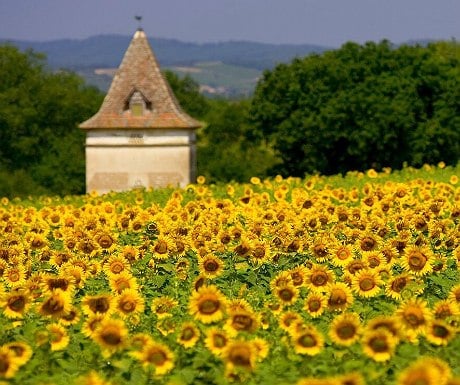 Occitanie? It’s the administrative replacement for Languedoc-Rousillion and Midi-Pyrenees bureaucratically butchered at midnight on 31st January 2015.
As Provence’s country sister, Occitanie does decadence in its own bucolic way – enjoying the traditional luxuries of good-food, fine wines and the time to savour them. For this rural paradise of quiet roads winding through vines and sunflowers hedonistically lives off the fat of the land.
With it hill-top mediaeval villages, Occitanie has more than it’s fair share of France’s “plus beaux villages”. There’s plenty to rival showy Provence with its designer sunglasses, crawling autoroutes and inflated price tags.
1. Cultured Auch
Auch has slowed down since the Middle Ages. Once bustling with pilgrims on their way to Santiago de Compostella, now it seems that the massive cathedral has outgrown its city.
Occitanie? It’s the administrative replacement for Languedoc-Rousillion and Midi-Pyrenees bureaucratically butchered at midnight on 31st January 2015.
As Provence’s country sister, Occitanie does decadence in its own bucolic way – enjoying the traditional luxuries of good-food, fine wines and the time to savour them. For this rural paradise of quiet roads winding through vines and sunflowers hedonistically lives off the fat of the land.
With it hill-top mediaeval villages, Occitanie has more than it’s fair share of France’s “plus beaux villages”. There’s plenty to rival showy Provence with its designer sunglasses, crawling autoroutes and inflated price tags.
1. Cultured Auch
Auch has slowed down since the Middle Ages. Once bustling with pilgrims on their way to Santiago de Compostella, now it seems that the massive cathedral has outgrown its city.
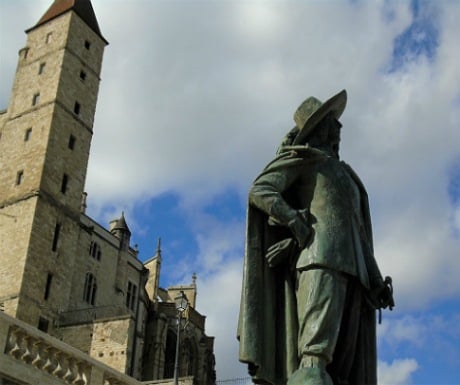 As the historic heart of Gascony, in the department of Gers, pronounced rather like the beginning of Jerez, Auch’s quaint meandering cobbled streets slow you to Occitanie’s gentle strolling pace. Linger at your restaurant table, on the square, admiring buildings that survive from medieval times and some sharp topiary.
Visitors often guess that they could fit Auch’s entire population into the schizophrenic cathedral: Gothic exterior with Renaissance interior. Construction began in 1489 but by the time it was completed in the 17th century Gothic’s over-the- top fetish of ornate decoration was passé. To a 21st century minimalist eye Renaissance style also seems over-the-top.
D’Artagnan, of Three Musketeers fame, born nearby, is Auch’s local boy made good, and his statue stands behind the cathedral. The cathedral is at the heart of Auch’s lively arts programme and you may be able to catch a concert.
2. Chambres d’hôtes
Small, quirky, welcoming chambres d’hôtes, tucked away off gravelled lanes are the way to go in Occitanie. You are a guest rather than a customer. Stay in your own tower at Les Bruhasses, near Condom, mezzanine bedroom with lounge below. Garrulous Jean Royer, with numerous anecdotes of rural French life entertains you whilst his wife Helene plates up the local specialities and keeps the wine flowing. Gourmet food and immaculate English testifies to their past life of running a restaurant in Canada. But they wanted their children to enjoy French rural life, so they returned to their home land.
As the historic heart of Gascony, in the department of Gers, pronounced rather like the beginning of Jerez, Auch’s quaint meandering cobbled streets slow you to Occitanie’s gentle strolling pace. Linger at your restaurant table, on the square, admiring buildings that survive from medieval times and some sharp topiary.
Visitors often guess that they could fit Auch’s entire population into the schizophrenic cathedral: Gothic exterior with Renaissance interior. Construction began in 1489 but by the time it was completed in the 17th century Gothic’s over-the- top fetish of ornate decoration was passé. To a 21st century minimalist eye Renaissance style also seems over-the-top.
D’Artagnan, of Three Musketeers fame, born nearby, is Auch’s local boy made good, and his statue stands behind the cathedral. The cathedral is at the heart of Auch’s lively arts programme and you may be able to catch a concert.
2. Chambres d’hôtes
Small, quirky, welcoming chambres d’hôtes, tucked away off gravelled lanes are the way to go in Occitanie. You are a guest rather than a customer. Stay in your own tower at Les Bruhasses, near Condom, mezzanine bedroom with lounge below. Garrulous Jean Royer, with numerous anecdotes of rural French life entertains you whilst his wife Helene plates up the local specialities and keeps the wine flowing. Gourmet food and immaculate English testifies to their past life of running a restaurant in Canada. But they wanted their children to enjoy French rural life, so they returned to their home land.
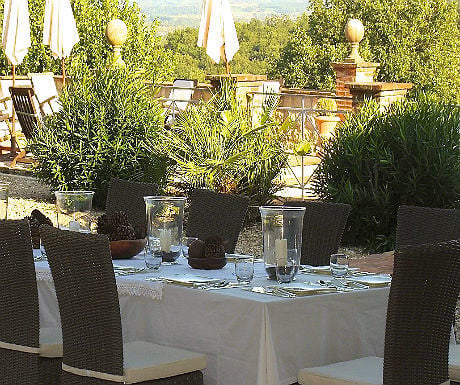 Quite simply oatmeal-coloured Domaine de Perches with its pool, probably Farrow and Ball “pitch blue” to complement the Negrette vineyards beyond, is the ultimate property porn. Picture windows framing sunset over the distant Montaigne Noire, an eclectic mix of antiques and contemporary art. Then when the sun has finally set – strategically placed table-lamps creating warm pools of light.
If you choose to park-up for the night Alain and Howard will share canapés with you, “a glass of something sparkling” and then a four-course dinner. In summer the table will be set al fresco on the decking by the pool. Idyllic is a word that cannot be overused at Domaine.
3. The village that floats in the sky
As one of the “Plus beaux villages” Cordes-sue- ciel is not to be missed. It’s a medieval
village that appears to float amongst the clouds on a misty day. Visitors park and then breathlessly climb the steep labyrinthian streets taking them past half-timbered houses that showcase the work of cedar wood carvers, painters and textile weavers. Enjoy vineyard views from cafes and restaurants at the summit.
Quite simply oatmeal-coloured Domaine de Perches with its pool, probably Farrow and Ball “pitch blue” to complement the Negrette vineyards beyond, is the ultimate property porn. Picture windows framing sunset over the distant Montaigne Noire, an eclectic mix of antiques and contemporary art. Then when the sun has finally set – strategically placed table-lamps creating warm pools of light.
If you choose to park-up for the night Alain and Howard will share canapés with you, “a glass of something sparkling” and then a four-course dinner. In summer the table will be set al fresco on the decking by the pool. Idyllic is a word that cannot be overused at Domaine.
3. The village that floats in the sky
As one of the “Plus beaux villages” Cordes-sue- ciel is not to be missed. It’s a medieval
village that appears to float amongst the clouds on a misty day. Visitors park and then breathlessly climb the steep labyrinthian streets taking them past half-timbered houses that showcase the work of cedar wood carvers, painters and textile weavers. Enjoy vineyard views from cafes and restaurants at the summit.
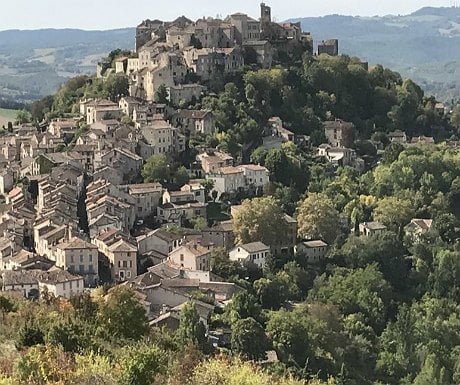 Founded in 1222 Cordes was intended to be France’s answer to the commercial success of Spain‘s Córdoba. Layer after layer of defensive ramparts demonstrate how the plan worked, Cordes grew and grew.
4. Cloisters and Cezanne
A tour of the Abbey at Flaran takes you back in time, to the abbey’s foundation in 1511, to rough-textured habits and an era of just one meal a day. Cistercian monks rose almost before they had gone to bed with first prayers at 2.30am. Trivia note: Cistercian originates from the French for the rushes found near the order’s original establishment at Citeaux.
Founded in 1222 Cordes was intended to be France’s answer to the commercial success of Spain‘s Córdoba. Layer after layer of defensive ramparts demonstrate how the plan worked, Cordes grew and grew.
4. Cloisters and Cezanne
A tour of the Abbey at Flaran takes you back in time, to the abbey’s foundation in 1511, to rough-textured habits and an era of just one meal a day. Cistercian monks rose almost before they had gone to bed with first prayers at 2.30am. Trivia note: Cistercian originates from the French for the rushes found near the order’s original establishment at Citeaux.
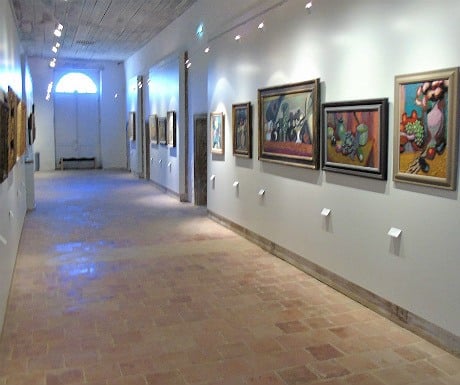 Don’t waste time taking too many photos of the cloisters. At nearby Moissac you can devoutly walk through probably the oldest and best cloisters in the world, far more photogenic. To back their claim to fame the cloisters are UNESCO listed and protected.
Bizarrely this once austere and simple white-walled monastery at Flaran is also home to Michael Romanov’s priceless art collection. Today the monks’ former dormitory houses works by Cézanne, Renoir, Matisse, Picasso, Monet, Braque, Tiepolo, Rubens, Courbet and Rodin – far from the frustrating crowds of Paris’ galleries.
5. Canal des Deux Mers
There are those, with blisters, who choose to cycle, row or walk this challenging 750km route, the Canal des Deux Mers links the Atlantic with the Mediterranean.
Don’t waste time taking too many photos of the cloisters. At nearby Moissac you can devoutly walk through probably the oldest and best cloisters in the world, far more photogenic. To back their claim to fame the cloisters are UNESCO listed and protected.
Bizarrely this once austere and simple white-walled monastery at Flaran is also home to Michael Romanov’s priceless art collection. Today the monks’ former dormitory houses works by Cézanne, Renoir, Matisse, Picasso, Monet, Braque, Tiepolo, Rubens, Courbet and Rodin – far from the frustrating crowds of Paris’ galleries.
5. Canal des Deux Mers
There are those, with blisters, who choose to cycle, row or walk this challenging 750km route, the Canal des Deux Mers links the Atlantic with the Mediterranean.
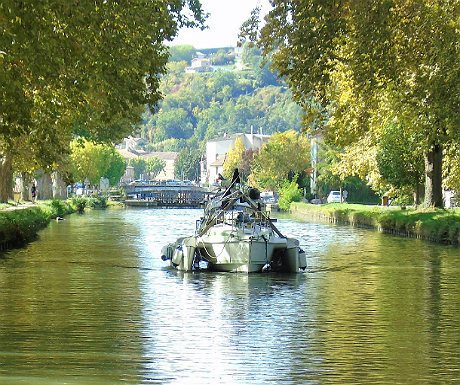 Alternatively, staying in Occitanie, you could sample some of the 138 kilometres that flow from Toulouse to Carcassonne, the 17th century Canal du Midi is also UNESCO listed. Perhaps hiring a bike in Toulouse or Moissac, for a morning, is a sensible option. Even more attractive is a gastronomic lunch or dinner cruise on the Occitane sailing out of Toulouse
6. Learn the skills of a sommelier
Slow-travel on a horse and cart around a Fronton vineyard, with your guide pointing out the rose bushes that serve as an early indicator of disease and the lavender attracting pollinating bees, is a leisurely way to become one with the landscape.
Alternatively, staying in Occitanie, you could sample some of the 138 kilometres that flow from Toulouse to Carcassonne, the 17th century Canal du Midi is also UNESCO listed. Perhaps hiring a bike in Toulouse or Moissac, for a morning, is a sensible option. Even more attractive is a gastronomic lunch or dinner cruise on the Occitane sailing out of Toulouse
6. Learn the skills of a sommelier
Slow-travel on a horse and cart around a Fronton vineyard, with your guide pointing out the rose bushes that serve as an early indicator of disease and the lavender attracting pollinating bees, is a leisurely way to become one with the landscape.
 The wines of Occitanie may not be big-hitting household names such as Bordeaux, Burgundy, Merlot or Syrah but the white-tinted soil of crumbled limestone grows some fine vintages particularly from the black Negrette grapes – with more reasonable price tags too. Tour a vineyard, such as Chateau Saurs, with its Italianate Chateau and formal gardens and its unique feature of a sculpture of watering cans, and you learn as much of the family’s way of life as you do of the wines.
Come late autumn when the vines have been harvested and there’s a morning nip in the air, Occitanie, with its hillsides of reddening vines, displays a brown-rust-orange palette worthy of a New England fall.
7. Inspirational restoration
Us Brits love the Grand Designs dream. Take a run-down pile of stone in Provence, Tuscany or anywhere cultured, Continental and ten degrees warmer than Aylesbury. Then add inspiration, love and your life-savings to enable a Chateau with a contemporary tweak to rise Phoenix-like from the rubble.
The wines of Occitanie may not be big-hitting household names such as Bordeaux, Burgundy, Merlot or Syrah but the white-tinted soil of crumbled limestone grows some fine vintages particularly from the black Negrette grapes – with more reasonable price tags too. Tour a vineyard, such as Chateau Saurs, with its Italianate Chateau and formal gardens and its unique feature of a sculpture of watering cans, and you learn as much of the family’s way of life as you do of the wines.
Come late autumn when the vines have been harvested and there’s a morning nip in the air, Occitanie, with its hillsides of reddening vines, displays a brown-rust-orange palette worthy of a New England fall.
7. Inspirational restoration
Us Brits love the Grand Designs dream. Take a run-down pile of stone in Provence, Tuscany or anywhere cultured, Continental and ten degrees warmer than Aylesbury. Then add inspiration, love and your life-savings to enable a Chateau with a contemporary tweak to rise Phoenix-like from the rubble.
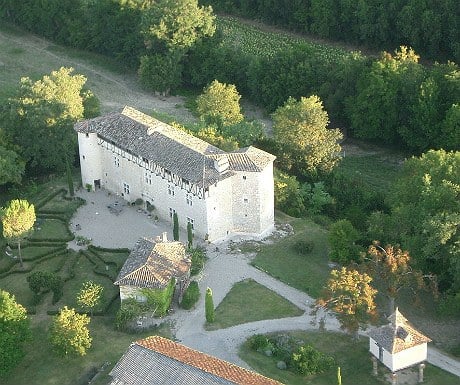 At Chateau Mayragues, the hardworking and rather gaunt Duncan Geddes will guide you around the estate narrating the epic tale of how his Scottish father and French mother bought the collapsed Chateau in 1980. He provides photographs to show the original derelict state of the roofless building. During your wine-tasting he will explain how his father ran the vineyard and restored the house whilst the family lived in a caravan for several years. Now you can take B & B in one of the two immaculately restored timbered rooms.
This epic tale, with a Scottish flag on every bottle, is the stuff of a feel-good soft-focus Hollywood movie.
8. Armagnac – the angels’ share
With its huge white cobwebs hanging between windows and barrels – spiders welcome as they devour any bacteria that would harm the Armagnac – the Delord Distillery, run by the family now for four generation, drips tradition. Jacques Delord still uses his ink-pen calligraphy skills for the ornate labels of the twice-distilled white grape juice.
At Chateau Mayragues, the hardworking and rather gaunt Duncan Geddes will guide you around the estate narrating the epic tale of how his Scottish father and French mother bought the collapsed Chateau in 1980. He provides photographs to show the original derelict state of the roofless building. During your wine-tasting he will explain how his father ran the vineyard and restored the house whilst the family lived in a caravan for several years. Now you can take B & B in one of the two immaculately restored timbered rooms.
This epic tale, with a Scottish flag on every bottle, is the stuff of a feel-good soft-focus Hollywood movie.
8. Armagnac – the angels’ share
With its huge white cobwebs hanging between windows and barrels – spiders welcome as they devour any bacteria that would harm the Armagnac – the Delord Distillery, run by the family now for four generation, drips tradition. Jacques Delord still uses his ink-pen calligraphy skills for the ornate labels of the twice-distilled white grape juice.
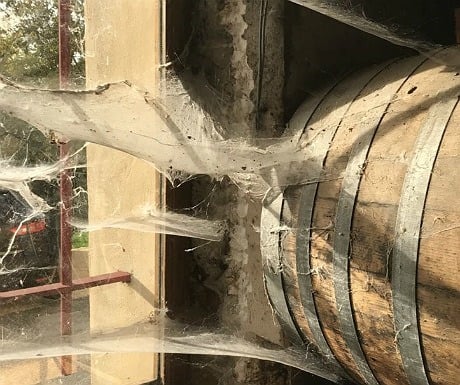 “This is heaven,” said our guide opening the doors to a loft containing the distillery’s finest vintages. There is even a heavenly aroma, appropriate too as “the angels’ share” takes 2% of every distillation.
“Try the white Armagnac” advises our guide. “Keep it in your freezer at -20 C and use it as a base for cocktails. For an instant desert, drizzle it over ice-cream or sorbet.”
9. Let them eat foie gras
Love it or loathe it, Occitanie is World Duck HQ for foie gras. There’s even a Foie Gras Museum at Souleilles. Whatever your moral take on foie gras – and Christine Legarde at Le Terre Blanche Duck Farm, near Condom, argues that force-feeding ducks corn to expand their liver is merely replicating ducks’ natural tendency to stock-up before migrating – there’s no denying foie gras’ impact on Occitanie cuisine. But stay in the back row during her duck cookery demonstration. Tasting slimy raw foie gras, even with a touch of olive oil plus salt and pepper, is something of a Bush Tucker Trial moment on ‘I’m a celebrity, get me out of here’.
“This is heaven,” said our guide opening the doors to a loft containing the distillery’s finest vintages. There is even a heavenly aroma, appropriate too as “the angels’ share” takes 2% of every distillation.
“Try the white Armagnac” advises our guide. “Keep it in your freezer at -20 C and use it as a base for cocktails. For an instant desert, drizzle it over ice-cream or sorbet.”
9. Let them eat foie gras
Love it or loathe it, Occitanie is World Duck HQ for foie gras. There’s even a Foie Gras Museum at Souleilles. Whatever your moral take on foie gras – and Christine Legarde at Le Terre Blanche Duck Farm, near Condom, argues that force-feeding ducks corn to expand their liver is merely replicating ducks’ natural tendency to stock-up before migrating – there’s no denying foie gras’ impact on Occitanie cuisine. But stay in the back row during her duck cookery demonstration. Tasting slimy raw foie gras, even with a touch of olive oil plus salt and pepper, is something of a Bush Tucker Trial moment on ‘I’m a celebrity, get me out of here’.
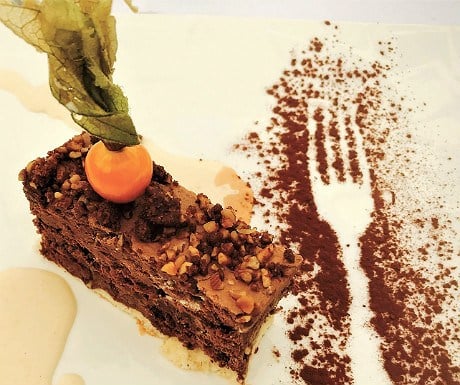 Creative chefs may offer a starter of foie gras and pistachio creme brûlée, Foie gras and red
pepper, Foie gras and apples in filo pastry or dozens of other imaginative alternatives. Fortunately, Occitanie’s culinary creativity extends beyond foie gras. A Basil sorbet on a sea of crushed meringues and lemon yogurt and sultanas, that’s a desert, epitomises the gastronomic flair with local ingredients.
10. Toulouse – la ville rose
If you have to leave this rural time bubble, and Occitanie has a feel of a rural France of three
decades ago, then Toulouse, even with its manic ring-road, is as good a portal as any for a
soft-landing return to the 21st century.
For centuries, Toulouse with its sought after blue dye was at the heart of the region’s wealth. Yet there’s a pink tinge to the architecture, particularly at sunset, from traces of iron in the clay that made the bricks.
Creative chefs may offer a starter of foie gras and pistachio creme brûlée, Foie gras and red
pepper, Foie gras and apples in filo pastry or dozens of other imaginative alternatives. Fortunately, Occitanie’s culinary creativity extends beyond foie gras. A Basil sorbet on a sea of crushed meringues and lemon yogurt and sultanas, that’s a desert, epitomises the gastronomic flair with local ingredients.
10. Toulouse – la ville rose
If you have to leave this rural time bubble, and Occitanie has a feel of a rural France of three
decades ago, then Toulouse, even with its manic ring-road, is as good a portal as any for a
soft-landing return to the 21st century.
For centuries, Toulouse with its sought after blue dye was at the heart of the region’s wealth. Yet there’s a pink tinge to the architecture, particularly at sunset, from traces of iron in the clay that made the bricks.
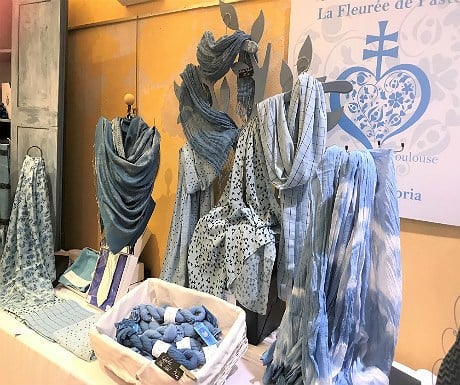 For centuries Toulouse trade combined with surrounding farms to make this the land of milk-and-honey. Now it is Airbus, a major employer, which flies in the Euros. With a thriving university, students – relaxing by the river, arguing politics, carrying a cello or violin to a rehearsal – contribute to the party atmosphere in France’s fourth largest city.
But on Tuesdays and Saturdays the organic market takes Toulouse back to its roots while every day the covered aromatic food market gives you one last taste of Occitanie with its fondness for offal, cheeses, olives and wines.
For centuries Toulouse trade combined with surrounding farms to make this the land of milk-and-honey. Now it is Airbus, a major employer, which flies in the Euros. With a thriving university, students – relaxing by the river, arguing politics, carrying a cello or violin to a rehearsal – contribute to the party atmosphere in France’s fourth largest city.
But on Tuesdays and Saturdays the organic market takes Toulouse back to its roots while every day the covered aromatic food market gives you one last taste of Occitanie with its fondness for offal, cheeses, olives and wines.Did you enjoy this article?
Receive similar content direct to your inbox.



Thank you for your delightful article highlighting the “other Provence”, a phrase I often use to describe where I live. Well done!
This looks like such a fun and quirky place to go on vacation. I love the idea of staying in your own tower and would massively enjoy walking along the canal especially if there was some wine waiting at the end of the day.
Fantastic article about this hidden gem of France.
To the part of Toulouse: it’s Airbus, not Autobus : )
Cheers, Doris
Thanks for this, Doris… I have updated the typo. :)